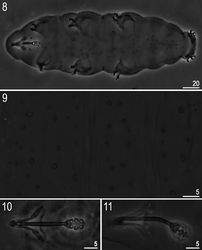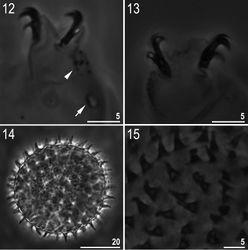Minibiotus formosus
| Notice: | This page is derived from the original publication listed below, whose author(s) should always be credited. Further contributors may edit and improve the content of this page and, consequently, need to be credited as well (see page history). Any assessment of factual correctness requires a careful review of the original article as well as of subsequent contributions.
If you are uncertain whether your planned contribution is correct or not, we suggest that you use the associated discussion page instead of editing the page directly. This page should be cited as follows (rationale):
Citation formats to copy and paste
BibTeX: @article{Zawierucha2014ZooKeys408, RIS/ Endnote: TY - JOUR Wikipedia/ Citizendium: <ref name="Zawierucha2014ZooKeys408">{{Citation See also the citation download page at the journal. |
Genus: Minibiotus
Name
Minibiotus formosus Zawierucha, Dziamięcki, Jakubowska, Michalczyk & Kaczmarek, 2014 sp. n. – Wikispecies link – ZooBank link – Pensoft Profile
Type material
Holotype and 23 paratypes, 24 specimens (including 2 simplexes) and 3 unembryonated eggs).
Type locality
57°10'33"N, 24°50'32"E, ca. 45 m asl: Latvia, Vidzeme region, Sigulda municipality, Gutmana Cave in the Gauja National Park; moss from rock (1 sample, slide codes: ŁO 2427/*, where the asterisk can be substituted by any of the following numbers: 1, 2, 3, 4, 5, 6, 7, 8, 9, 10, 11, 12).
Description
(measurements in Table 2). Body white/colourless (Fig. 8). Eyes present in 18 of 24 (75%) specimens mounted in Hoyer’s medium. Entire cuticle covered with small (0.4–1.1 μm) and large (1.9–2.5 μm) round or oval pores (Fig. 9). Pores arranged in 9–10 poorly defined transverse bands. Pores on the dorsal cuticle arranged more densely than on the ventral cuticle. A single large pore (diameter: 2.1–2.9 μm) present on external side of legs I–III (Fig. 12, arrow). A ring of pores around the mouth opening absent. Cuticle without granulation, except for legs which are all covered with fine and regular granulation (better developed on legs IV) visible only in larger specimens (Fig. 12, arrowhead).
| CHARACTER | N | RANGE | MEAN | SD | Holotype | ||||||||
|---|---|---|---|---|---|---|---|---|---|---|---|---|---|
| µm | pt | µm | pt | µm | pt | µm | pt | ||||||
| Body length | 7 | 113 | – | 236 | 636 | – | 1034 | 184 | 901 | 39 | 139 | 194 | 848 |
| Buccal tube | |||||||||||||
| Length | 9 | 17.7 | – | 22.9 | – | 20.3 | – | 1.7 | – | 22.9 | – | ||
| Stylet support insertion point | 9 | 9.5 | – | 12.2 | 49.5 | – | 56.2 | 10.9 | 53.8 | 0.9 | 2.0 | 12.2 | 53.3 |
| External width | 9 | 1.3 | – | 2.0 | 7.0 | – | 9.9 | 1.6 | 7.8 | 0.2 | 0.8 | 1.7 | 7.4 |
| Internal width | 9 | 0.5 | – | 0.7 | 2.4 | – | 3.4 | 0.6 | 2.8 | 0.1 | 0.3 | 0.7 | 3.1 |
| Placoid lengths | |||||||||||||
| Macroplacoid 1 | 9 | 1.3 | – | 1.9 | 6.9 | – | 8.3 | 1.5 | 7.6 | 0.2 | 0.4 | 1.8 | 7.9 |
| Macroplacoid 2 | 9 | 1.2 | – | 1.7 | 6.8 | – | 8.3 | 1.5 | 7.5 | 0.2 | 0.4 | 1.7 | 7.4 |
| Macroplacoid 3 | 9 | 1.4 | – | 2.2 | 7.4 | – | 9.6 | 1.7 | 8.2 | 0.3 | 0.6 | 1.9 | 8.3 |
| Microplacoid | 8 | 0.5 | – | 0.9 | 2.4 | – | 4.7 | 0.7 | 3.3 | 0.1 | 0.8 | 0.8 | 3.5 |
| Macroplacoid row | 9 | 4.5 | – | 6.8 | 24.3 | – | 33.7 | 5.5 | 26.9 | 0.7 | 3.0 | 5.9 | 25.8 |
| Placoid row | 8 | 5.2 | – | 7.9 | 27.1 | – | 39.1 | 6.4 | 31.0 | 0.9 | 3.9 | 6.7 | 29.3 |
| Claw 1 lengths | |||||||||||||
| External primary branch | 4 | 4.7 | – | 6.5 | 22.8 | – | 31.6 | 5.8 | 27.7 | 0.8 | 3.7 | 6.2 | 27.1 |
| External secondary branch | 3 | 3.6 | – | 4.3 | 17.5 | – | 20.9 | 3.9 | 19.4 | 0.4 | 1.7 | ? | ? |
| Internal primary branch | 6 | 4.7 | – | 6.6 | 24.3 | – | 30.4 | 5.7 | 27.4 | 0.7 | 2.4 | 6.3 | 27.5 |
| Internal secondary branch | 5 | 3.1 | – | 4.6 | 15.0 | – | 20.4 | 4.0 | 18.7 | 0.5 | 2.3 | 4.6 | 20.1 |
| Claw 2 lengths | |||||||||||||
| External primary branch | 5 | 5.2 | – | 6.9 | 25.2 | – | 34.0 | 5.9 | 28.6 | 0.6 | 3.5 | 5.9 | 25.8 |
| External secondary branch | 4 | 3.3 | – | 4.7 | 16.0 | – | 23.2 | 3.9 | 19.4 | 0.6 | 2.9 | ? | ? |
| Internal primary branch | 5 | 5.2 | – | 6.4 | 27.1 | – | 31.9 | 6.0 | 29.7 | 0.5 | 2.3 | 6.2 | 27.1 |
| Internal secondary branch | 3 | 3.5 | – | 4.1 | 18.5 | – | 20.9 | 3.9 | 19.9 | 0.3 | 1.3 | ? | ? |
| Claw 3 lengths | |||||||||||||
| External primary branch | 5 | 5.1 | – | 6.9 | 27.0 | – | 33.2 | 6.3 | 30.6 | 0.7 | 2.4 | 6.9 | 30.1 |
| External secondary branch | 6 | 3.6 | – | 4.9 | 19.0 | – | 24.1 | 4.6 | 22.1 | 0.5 | 1.8 | 4.9 | 21.4 |
| Internal primary branch | 7 | 5.1 | – | 6.6 | 25.7 | – | 32.5 | 5.9 | 29.2 | 0.6 | 2.5 | 6.4 | 27.9 |
| Internal secondary branch | 4 | 4.1 | – | 4.6 | 20.9 | – | 22.8 | 4.3 | 21.6 | 0.2 | 0.8 | ? | ? |
| Claw 4 lengths | |||||||||||||
| Anterior primary branch | 5 | 6.0 | – | 8.0 | 31.6 | – | 39.6 | 7.0 | 34.2 | 0.8 | 3.5 | ? | ? |
| Anterior secondary branch | 4 | 4.0 | – | 6.0 | 21.2 | – | 29.7 | 5.0 | 24.1 | 0.9 | 3.9 | ? | ? |
| Posterior primary branch | 6 | 6.0 | – | 7.8 | 30.7 | – | 38.4 | 7.0 | 33.9 | 0.7 | 3.1 | ? | ? |
| Posterior secondary branch | 5 | 3.9 | – | 5.5 | 20.6 | – | 27.1 | 4.8 | 23.8 | 0.6 | 2.6 | ? | ? |
Claws of the Macrobiotus type (Figs 12–13). Primary branches of claws with thin, but obvious accessory points detaching at the apogee of the primary branch curve. Smooth lunules present on all legs, distinctly larger under external and posterior claws. Bars and other cuticular thickenings on legs absent.
Eggs (measurements in Table 3). White/transparent, laid freely (Fig. 14). Spherical, without areolation. Processes in the shape of short, smooth, slightly flexible cones (Fig. 15). Processes are distributed on the surface of the egg close one to another but never in contact. Surface between processes smooth under PCM (Fig. 15).
| CHARACTER | egg 1 | egg 2 | egg 3 |
|---|---|---|---|
| Diameter of egg without processes | 45.7 | 44.1 | ? |
| Diameter of egg with processes | 55.6 | 55.1 | ? |
| Process height | 4.5–5.2 | 4.8–5.2 | 4.6–5.3 |
| Process base width | 2.8–3.4 | 2.8–3.1 | 2.4–2.6 |
| Process base/height ratio | 57%–69% | 54%–65% | 47%–57% |
| Distance between processes | 2.0–2.5 | 1.9–3.9 | 1.8–2.0 |
| Number of processes on the egg circumference | 30 | 29 | 30 |
Remarks
Since ventral lamina is very poorly visible, the measurements of this structure are not included in Table 2. Three unembryonated eggs have been found alongside the described specimens. Given that Minibiotus formosus sp. n. was the only Minibiotus species in the sample and because no Ramazzottius Binda & Pilato, 1986 was found in the samples, we assumed that these eggs belong to the new species.
Etymology
Given that we found the composition of small and large pores in the new species beautiful, we decided to name the animal after this impression (in Latin ‘formosus’ means ‘beautiful’).
Type depositories
Holotype 23 paratypes and 3 eggs are deposited in the Department of Animal Taxonomy and Ecology at the Adam Mickiewicz University (Poznań, Poland).
Original Description
- Zawierucha, K; Dziamięcki, J; Jakubowska, N; Michalczyk, Ł; Kaczmarek, Ł; 2014: New tardigrade records for the Baltic states with a description of Minibiotus formosus sp. n. (Eutardigrada, Macrobiotidae) ZooKeys, 408: 81-105. doi
Images
|

